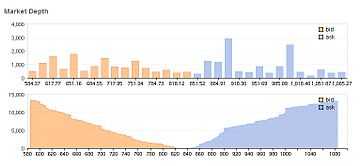Market depth

In finance, market depth is about quantity to be sold versus unit price. Mathematically, it is the size of an order needed to move the market price by a given amount. If the market is deep, a large order is needed to change the price.
Market depth is a property of the orders that are contained in the limit order book at a given time. It is the amount that will be traded for a limit order with a given price (if it is not limited by size), or the least favorable price that will be obtained by a market order with a given size (or a limit order that is limited by size and not price). Although a change in price may in turn attract subsequent orders, this is not included in market depth since it is not known.
A country’s financial structure is composed of a mixture of banks, non-bank financial institutions (NBFIs), and the financial markets. Financial depth is used as a measure of the size of financial institutions and financial markets in a country.[1] Well‐developed financial systems are deep, i.e. sizeable relative to the overall size of the economy, and provide the economy with credit and other financial services.
Studies show a strong correlation between financial depth, long‐term economic growth and poverty reduction.[2] Globally, the annual average value of private credit across countries was 39 percent with a standard deviation of 36 percent. Averaging over the time period of 1980–2010, private credit constitute less than 10 percent of GDP in Angola, Cambodia, and Yemen, while exceeding 85 percent of GDP in Austria, China and the United Kingdom. For financial markets, research has shown that the trading of firms’ ownership (e.g. through stock exchanges) in an economy is closely tied to the rate of economic development. For instance, the average of total value of stock traded is about 29 percent of GDP. In less developed countries such as Armenia, Tanzania, and Uruguay, stock value traded annually averaged less than 0.23% over the 1980‐2008 sample (10th percentile). In contrast, stock value traded averaged over 75 percent in China (both Mainland and Hong Kong SAR), Saudi Arabia, Switzerland, and the United States (90th percentile).[3]
Measurement
Multiple proxies are in use to measure financial depth. For financial institutions, the most common measurements are private credit as a percentage of GDP and total banking assets to GDP. Private credit is defined as the amount of deposit money credited to the private sector by banks, while total banking assets include credit to government and bank assets other than private credit. Aside from these two bank-related measures of financial depths, there are a few non-bank financial institutions (NBFIs) proxies such as total assets of NBFIs to GDP, which includes mutual fund assets to GDP, pension fund assets to GDP, insurance company assets to GDP, insurance premiums (life) to GDP, and insurance premiums (non‐life) to GDP. ).[4]
For financial markets, the focus is on measuring the size of stock markets and bond markets ( two main segments of the financial market). The relevant proxies are stock market capitalization to GDP and outstanding volume of debt securities (private and public) to GDP respectively. Other market development indicators include stock market transactions as a share of GDP.[5] Stock market capitalization measures the value of listed shares on a country’s stock exchanges as a share of GDP, while stock market transactions indicator incorporates information on the size and activity of the stock market, not only the value of listed shares.
The ratio of the depth indicators for banks and financial markets, called the financial structure ratio, can show insights into the relative mixture of financial institutions and financial markets in a system. The degree to which the financial system is ‘bank‐based’ or market‐based’ worth investigating, as literature has shown that when a country develops, services provided by financial markets tend to gain prominence as opposed to those provided by banks.[6]
Factors influencing market depth
- Tick size. This refers to the minimum price increment at which trades may be made on the market. The major stock markets in the United States went through a process of decimalisation in April 2001. This switched the minimum increment from a sixteenth to a one hundredth of a dollar. This decision improved market depth.[7]
- Price movement restrictions. Most major financial markets do not allow completely free exchange of the products they trade, but instead restrict price movement in well-intentioned ways. These include session price change limits on major commodity markets and program trading curbs on the NYSE, which disallow certain large basket trades after the Dow Jones Industrial Average has moved up or down 200 points in a session.
- Trading restrictions. These include futures contract and options position limits as well as the widely used uptick rule for US stocks. These prevent market participants from adding to depth when they might otherwise choose to do so.
- Allowable leverage. Major markets and governing bodies typically set minimum margin requirements for trading various products. While this may act to stabilize the marketplace, it decreases the market depth simply because participants otherwise willing to take on very high leverage cannot do so without providing more capital.
- Market transparency. While the latest bid or ask price is usually available for most participants, additional information about the size of these offers and pending bids or offers that are not the best are sometimes hidden for reasons of technical complexity or simplicity. This decrease in available information can affect the willingness of participants to add to market depth.
In some cases, the term refers to financial data feeds available from exchanges or brokers. An example would be NASDAQ Level II quote data.
References
- ↑ McKinnon (1973), Shaw (1973) and Levine and King (1993)
- ↑ Demirgüç‐Kunt and Levine, 2008
- ↑ World bank GFDR Report
- ↑ World bank GFDR Report
- ↑ Levine and Zervos (1998)
- ↑ Demirgüç‐Kunt, Feyen, and Levine (2011)
- ↑ Market Depth, Investopedia